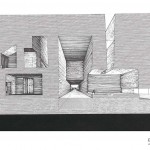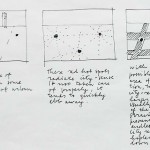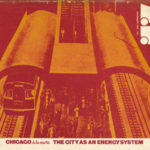
Claes Oldenburg, Proposed Colossal Monument for Thames River; Thames “Ball” 1967
Claes Oldenburg‘s unbuilt “Monuments” are imaginary anti-memorials designed by the artist at the end of the 1960s. Their paradoxical anti-monumental stance comes either from the will to commemorate a person, an event, a place or a concept for its negative impact instead than celebrate it, and from their capacity of being somehow “against” a city, its urban logic, its flows and its overall image.
Odenburg’s “Proposed Monument for the Intersection of Canal Street and Broadway, N.Y.C.- Block of Concrete with the Names of War Heroes“, for example, is an aggressive “monumental obstacle”: a giant block of concrete the same height of the surrounding buildings, which occupies the entire area of the intesection rendering it unusable. The drawings of the imaginary proposal were eventually sold at an auction for the benefit of anti-war congressional candidates.

Claes Oldenburg, Proposed Monument for the Intersection of Canal Street and Broadway, N.Y.C, 1965

Claes Oldenburg,Proposed Monument for the Intersection of Canal Street and Broadway, N.Y.C, 1965
“Monument to Immigration” is another “monumental obstacle”, a written proposal for a hidden reef on Ellis Island into which boats arriving to New York would crash, forming a graveyard of abandoned ships. Behind the proposal is the idea that arriving to New York was for many immigrants a harsher experience respect of what they expected. “For the artist, who was himself an immigrant, Monument to immigration disabuses the idealistic expectations of newcomers” (quote from: Claes Oldenburg: an Anthology – 1995, from: Mark Rosenthal: Unbridled Monuments; or, how Claes Oldenburg set out to change the world)
In “Ball”, a proposed colossal monument for the river Thames, 1967, conceived together with wife Coosje van Bruggen, giant toilets in the form of two vast balls float on the river underlining the unromantic image of the dirty water of the Thames. The Balls also represent an obstacle monument for the ships and boats.
The same concept is employed for a project for Park Avenue where two gigantic “Bowling Balls” would roll down the avenue endangering the passers-by. The proposal is an attempt by the artist to make visible his feeling that the street and the city in general is a dangerous place to live, where you must be quick and clever to survive both in a literal and in a metaphorical way.

Claes Oldenburg, Proposed Colossal Monument For Park Avenue, New York City: Bowling Balls, 1967

Claes Oldenburg, Proposed Colossal Monument for Thames River; Thames “Ball” 1967
“Many of my monuments reintroduce the idea of the monument as obstacle or disruption in the city. Many monuments, of course, are exactly that: the Arc de Triomphe, for one, is an aggressive obstacle in that traffic must be rerouted around it. So is my War Memorial: I wanted it to be like a wound in the city. Studies have indicated, in fact, that the intersection of Canal and Broadway, where the memorial would be, is the perfect spot to drop the H-bomb in order to create maximum damage and fallout throughout the New York area” (Claes Oldenburg in an interview with poet and editor Paul Carroll, 1968)

Claes Oldenburg, Proposed Colossal Monument for Park Avenue. New York: Good Humor Bar. 1965

Claes Oldenburg, The Scissor monument: a Proposal to Replace Washington Obelisk in Washington, Washington D.C.

Claes Oldenburg, The Scissor monument: a Proposal to Replace Washington Obelisk in Washington, Washington D.C.

Claes Oldenburg, Proposed Colossal Monument, Fan In Place Of The Statue Of Liberty, Bedloes Island, 1967

Claes Oldenburg, Proposal for a civic monument in the form of two windows

Claes Oldenburg, Proposed Monument for Mill Rock, East River, NYC: Slice of Strawberry Cheesecake, 1992

Claes Oldenburg, Lipsticks in Piccadilly Circus, London 1966
All images © Claes Oldenburg
Further reading:





Leave a Reply